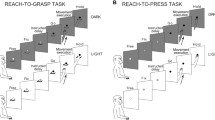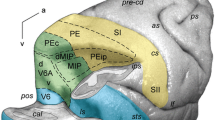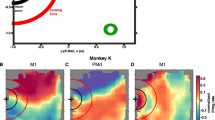Summary
Recordings were obtained from 146 neurons in the neostriatum of rhesus monkeys while they performed wrist movements in response to visual and vibratory cues. Of these, 75 putamen and 29 caudate neurons exhibited changes in firing rate that were temporally related to the onset of the wrist movements and that began prior to movement onset. This premovement activity (PMA) usually was directionally specific, in that the magnitude or direction of change in firing rates was different during flexion trials as compared to trials involving wrist extension. PMA onset usually preceded movement onset by more than 100 ms and in most instances preceded the average onset of task-related changes in electromyographic (EMG) activity in muscles of the wrist and forelimb. For most neurons. the changes in neuronal activity that began prior to movement were maintained during movement execution. However, approximately one-third of the neurons that exhibited PMA changed their firing rate in the opposite direction, relative to their PMA and to their baseline rate of activity, once the movement began. Several other neurons either exhibited PMA only or they altered their discharge rates during movement execution but did not exhibit PMA. These observations suggest that, despite the close temporal relationship between the onset of PMA and the onset of wrist movement, the neuronal mechanisms mediating the PMA may differ from those that occur during movement execution. The PMA onset of neostriatal neurons occurred earlier in visually cued than in vibratory cued trials. These differences were statistically significant only for flexion trials, however, in which movements were made against a load and in the same direction as the palmar vibratory stimulus. For trials involving wrist extension, PMA onsets for visually cued as compared with vibratory cued trials were not statistically different. These findings contrast with data obtained previously from somatosensory cortical neurons during performance of the same behavioral task. On average, PMA in the putamen began earlier, relative to movement onset, than it did in the somatosensory cortex. Moreover, in the somatosensory cortex, PMA onset occurred earlier in vibratory cued than in visually cued trials, irrespective of movement direction (Nelson 1988; Nelson and Douglas 1989). For putamen neurons, but not for caudate or cortical neurons, the onset of PMA also occurred significantly earlier during extension trials than flexion trials, irrespective of the modality of the “go-cue”. These modality-dependent and direction-dependent differences in the PMA onset of neostriatal neurons may reflect the responsiveness of these neurons to somatosensory inputs (e.g., load conditions and vibratory stimulation) that were associated with the behavioral task. These data confirm observations made by other investigators that a substantial proportion of neurons in the putamen exhibit movement-related changes in discharge rate that are initiated prior to task-related changes in EMG activity, and they further suggest that this PMA may be initiated sufficiently early to influence even the earliest task-related activity of cortical neurons.
Similar content being viewed by others
References
Aldridge JW, Anderson RJ, Murphy JT (1980) The role of the basal ganglia in controlling a movement initiated by a visually presented cue. Brain Res 192: 3–16
Alexander GE (1987) Selective neuronal discharge in monkey putamen reflects intended direction of planned limb movements. Exp Brain Res 67: 623–634
Alexander GE, Crutcher MD (1990) Preparation for movement: neural representations of intended direction in three motor areas of the monkey. J Neurophysiol 64: 133–150
Crutcher MD, Alexander GE (1990) Movement related neuronal activity selectively coding either direction or muscle pattern in three motor areas of the monkey. J Neurophysiol 64: 151–163
Crutcher MD, DeLong MR (1984a) Single cell studies of the primate putamen. I. Functional organization. Exp Brain Res 53: 233–243
Crutcher MD, DeLong MR (1984b) Single cell studies of primate putamen. II. Relations to direction of movement pattern of muscular activity. Exp Brain Res 53: 244–258
DeLong MR (1972) Activity of basal ganglia neurons during movement. Brain Res 40: 127–135
Denny-Brown D, Yanagisawa N (1976) The role of the basal ganglia in the initiation of movement. In: Yahr MD (eds) The basal ganglia. Results Publ Assoc Res Nerv Ment Dis 55: 115–149
Flaherty AW, Graybiel AM (1991) Corticostriatal transformations in the primate somatosensory system. Projections from physiologically mapped body-part representations. J Neurophysiol 66: 1249–1263
Hikosaka O, Samamoto M, Usui S (1989) Functional properties of monkey caudate neurons. I. Activities related to saccadic eye movements. J Neurophysiol 61(4): 780–798
Holsapple JW, Preston JB, Strick PL (1991) The origin of thalamic inputs to the “hand” representation in the primary motor cortex. J Neurosci 11: 2644–2654
Hore J, Meyer-Lohmann J, Brooks VB (1977) Basal ganglia cooling disables learned arm movements of monkeys in the absence of visual guidance. Science 195: 584–586
Kimura M (1986) The role of primate putamen neurons in the association of sensory stimuli with movement. Neurosci Res 3: 436–443
Kimura M (1990) Behaviorally contingent property of movementrelated activity of the primate putamen. J Neurophysiol 63: 1277–1296
Künzle H (1975) Bilateral projections from precentral motor cortex to the putamen and other parts of the basal ganglia. An autoradiographic study in Macaca fascicularis. Brain Res 88: 195–209
Künzle H (1977) Projections from the primary somatosensory cortex to basal ganglia and thalamus in the monkey. Exp Brain Res 30: 481–492
Liles SL (1985) Activity of neurons in putamen during active and passive movements of wrist. J Neurophysiol 53: 217–235
Liles SL, Updyke BV (1985) Projection of the digit and wrist area of precentral gyrus to the putamen: relation between topography and physiological properties of neurons in the putamen. Brain Res 339: 245–255
Marsden CD (1982) The mysterious motor function of the basal ganglia. Neurology 32: 514–539
Nambu A, Yoshida S, Jinnai K (1988) Projection on the motor cortex of thalamic neurons with pallidal input in the monkey. Exp Brain Res 71: 658–662
Neafsey EJ, Hull CD, Buchwald NA (1978) Preparation for movement in the cat. II. Unit activity in the basal ganglia and thalamus. Electroencephalogr Clin Neurophysiol 44: 714–723
Nelson RJ (1988) Set related and premovement related activity in primate primary somatosensory cortical neurons depends upon stimulus modality and subsequent movement. Brain Res Bull 21: 411–424
Nelson RJ, Douglas VD (1989) Changes in premovement activity in primary somatosensory cortex differ when monkeys make hand movements in response to visual vs. vibratory cues. Brain Res 484: 43–56
Nelson RJ, McCandlish CA, Douglas VD (1990) Reaction times differ for hand movements in response to visual vs. vibratory cues. Somatosens Mot Res 7: 337–352
Nelson RJ, Smith BN, Douglas VD (1991) Relationships between sensory responsiveness and premovement activity of quickly adapting neurons in areas 3b and 1 of monkey primary somatosensory cortex. Exp Brain Res 84: 75–90
Rolls ET, Thorpe SJ, Maddison SP (1983) Responses of striatal neurons in the behaving monkey. I. Head of the caudate nucleus. Behav Brain Res 7: 179–210
Schultz W, Romo R (1988) Neuronal activity in the monkey striatum during the initiation of movements. Exp Brain Res 71: 431–436
Selemon LD, Goldman-Rakic PS (1985) Longitudinal topography and interdigitation of corticostriatal projections in the rhesus monkey. J Neurosci 5: 776–794
Author information
Authors and Affiliations
Rights and permissions
About this article
Cite this article
Gardiner, T.W., Nelson, R.J. Striatal neuronal activity during the initiation and execution of hand movements made in response to visual and vibratory cues. Exp Brain Res 92, 15–26 (1992). https://doi.org/10.1007/BF00230379
Received:
Accepted:
Issue Date:
DOI: https://doi.org/10.1007/BF00230379




